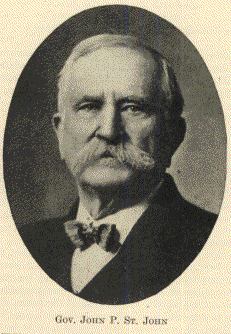| 1918 KANSAS AND KANSANS | Chapter 53 | Part 1 |
CHAPTER LIII
JOHN PIERCE ST. JOHN

Gov. JOHN P. ST. JOHN
[Copy by Willard of Portrait in Library of Kansas State Historical Society]
John Pierce St. John, the eighth governor of Kansas, was born at Brookville, Franklin County, Indiana, on the twenty-fifth of February, 1833. His parents came originally from New York State.
The first fourteen years of St. John's life were spent on his father's farm. The boy obtained only such education as the crude public schools of that period and locality furnished.
In 1848 he removed with his parents to Olney, Illinois. Here both his parents died soon after settling in their new home. In 1852 he crossed the plains to California. There he had a varied career - he mined, chopped wood, clerked - anything to pay his expenses. He also fought in the Indian Wars of 1853-54, in Northern California and Southern Oregon. Here he learned the endurance of a soldier, being twice wounded and often exposed to the greatest danger. But his early ambition to be lawyer never faltered during his life of adventure, and at night, after a day's hard work, he would study the few law books he had purchased, by the flickering light of the fire.
During this period of adventure, he visited Mexico, South America, the Sandwich Islands, and many other places of interest.
In 1859 he returned to Illinois, poor in purse, but rich in experience and knowledge of human nature. He completed his law studies in the offices of Starkweather and McLain, at Charleston, Coles County. In this city he married his wife, Susan J. Parker, on the twenty-eighth of March, 1860. Two children were born to them, John P. St. John, Jr., and Lulu.
During the Civil War, St. John served as Captain of Company C, 68th Illinois Volunteer Infantry, enlisting in April, 1862. Later he organized the 143d Regiment, Illinois Volunteer Infantry, of which he was Lieutenant-Colonel. He rendered gallant service during the war. In 1865 he moved to Independence, Missouri, where he practiced law for four years. He then located permanently in Olathe, Kansas.
St. John was an ardent Republican, standing firmly for whatsoever he believed to be right.
In 1872 he represented big district in the State Senate. In 1876 he declined the nomination for Governor of Kansas tendered to him by the Prohibition party. However, he was elected to that office two years later by the Republicans, and held the Governorship for two terms. He was defeated for a third term in 1882, by George W. Glick.
The Legislature of 1879 provided for the building of the west wing of the State House, and for the erection of a State Reform School, at Topeka. Also, as Governor St. John was a firm temperance man, and as the temperance movement was steadily gaining in power, the Legislature voted by a joint resolution to submit to a vote of the people an amendment to the Constitution of Kansas, prohibiting within the state the "manufacture and sale of intoxicating liquors," except for medical and scientific purposes. This amendment was adopted at the general election in 1880.
In 1881 the Legislature passed the Prohibitory Law, an act to enforce the constitutional amendment, and since then Kansas has stood staunchly for prohibition, and profited greatly thereby.
Beginning in 1874, many colored people emigrated to Kansas from the South. This emigration culminated in 1879 in a grand rush for Kansas by large numbers of ex-slaves. This influx was known as the "Exodus" and so important was it that the "Exoduster" became well known to Kansas politics and history. Poor, homeless, trustful, the Exoduster displayed the traits of his race in unfailing cheerfulness and childlike trust in Providence. A Freedman's State Central Association was formed, with Governor St. John at the head, and much was done for the relief of the negroes. Large sums of money were donated for that purpose. Many of the Exodusters grouped together and founded the town of Nicodemus, in Graham County. Others settled on small patches in the different Kansas towns and gradually acquired homes.
In 1869, by a treaty, the Osage Indians had sold their lands, amounting to 8,000,000 acres to the Leavenworth, Lawrence and Galveston Railroad Company. The settlers on the land feared they would lose their homes, so in 1874, suit was brought to test the validity of the patents issued to the Railroad companies for the Osage lands. After seven years of waiting, the case was decided in favor of the settlers.
During Governor St. John's administration, President Hayes and General Grant visited Kansas. They were much surprised and gratified at her excellent condition, and paid many compliments to her splendid schools and institutions, her patriotism and advancement.
Governor St. John's administration was distinguished for straightforward honesty. The Governor's enthusiasm for rigid standards of honor was so great as to almost amount to fanaticism. The administration was not marred by a single questionable act.
In 1884, when the Republican National Convention at Chicago refused to take any position against the saloon, he left the Republican party and joined the Prohibitionists. In July, 1885, he was nominated by that party for President and received over 150,000 votes. This defeated Blaine.
Later, he joined the People's Party in Kansas. He was always foremost in any party that seemed to him to offer most advantages for mankind.
Governor St. John died at Olathe at the age of eighty-three years, August 31, 1916.
The enactment of the statutes giving Kansas the Prohibitory Law came in the administration of Governor St. John, as already stated. This was the principal achievement of Governor St. John. It was an important event in the history of Kansas, and is treated in the following chapter.
| 1918 Kansas and Kansans | Previous Section | Next Section |
A Standard History of Kansas and Kansans , written and compiled by William E. Connelley, transcribed by Carolyn Ward, 1998.
